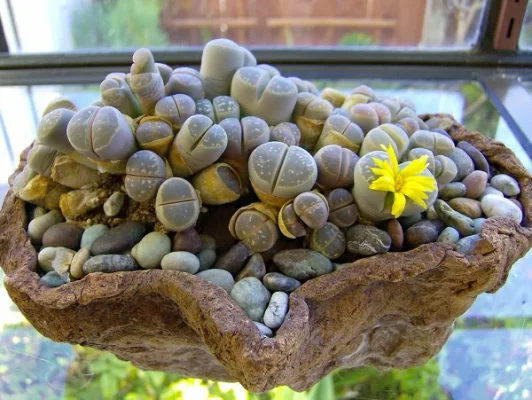Introduction
Lithops, often referred to as “living stones,” are a unique and fascinating group of succulent plants that have captured the hearts of plant enthusiasts worldwide. These remarkable plants are known for their striking resemblance to stones and pebbles, making them a favorite among collectors and gardeners alike. In this comprehensive guide, we will delve into the mesmerizing world of Lithops varieties, shedding light on their characteristics, care requirements, and the joy they bring to plant lovers.
Understanding Lithops: The Living Stones
Lithops, derived from the Greek words “lithos” (stone) and “ops” (face), are native to arid regions of southern Africa, where they have evolved to mimic the appearance of rocks as a survival strategy. These tiny, low-growing succulents often go unnoticed in their natural habitat, hiding among pebbles and blending seamlessly with their surroundings to avoid herbivores.
Despite their deceptive appearance, Lithops are living plants with unique and colorful features. Their fascinating diversity is a testament to nature’s creativity, offering a wide array of choices for collectors and enthusiasts.

A Glimpse into Lithops Varieties
- Lithops aucampiae: This variety is characterized by its round, flattened appearance, resembling split stones. It comes in various colors, including shades of green, pink, and brown, often with intricate patterns on the tops.
- Lithops optica: Known for its striking windowed leaves, Lithops optica features translucent areas that allow sunlight to penetrate, aiding in photosynthesis. It displays vibrant colors, such as shades of red, brown, and green.
- Lithops dorotheae: This variety is distinguished by its bright red to reddish-brown hues, making it one of the most visually striking Lithops. Its top surface often exhibits intricate patterns that add to its allure.
- Lithops schwantesii: With its elongated, cylindrical leaves and diverse color palette, ranging from green to purple, Lithops schwantesii is a popular choice among collectors. Its textured patterns and unique shapes are a delight to behold.
- Lithops bromfieldii: This variety showcases shades of gray and blue-green, along with a distinctive “horseshoe” pattern on the top surface. Its mesmerizing appearance is sure to captivate any observer.
- Lithops karasmontana: These Lithops are recognized for their globular, compact shape and various colors, including gray, brown, and green. They often feature fascinating patterns resembling puzzle pieces.
- Lithops julii: Lithops julii stands out for its unusual, jagged leaf margins and intriguing speckled or reticulated patterns on the tops of the leaves. The combination of textures and colors makes it a highly sought-after variety.

Caring for Lithops Varieties
Caring for Lithops can be a rewarding experience, but it requires attention to their specific needs:
- Well-Draining Soil: Plant your Lithops in a well-draining succulent mix to prevent waterlogged roots.
- Sunlight: Lithops thrive in bright, indirect sunlight. Ensure they receive at least 4-6 hours of indirect sunlight daily.
- Watering: These plants have a unique watering cycle, with periods of growth and dormancy. During the growing season (typically spring and autumn), water sparingly when the soil is completely dry. However, during dormancy (summer and winter), refrain from watering.
- Temperature: Lithops prefer temperatures between 70°F to 80°F (21°C to 27°C) during their active growth season. They can tolerate cooler temperatures during their dormant phase.
- Containers: Use shallow, wide pots to mimic their natural habitat and provide ample space for their underground growth.
- Pest and Disease Control: Keep an eye out for pests such as mealybugs and aphids. Treat infestations promptly with neem oil or insecticidal soap.
- Fertilization: Fertilize sparingly with a diluted, balanced liquid fertilizer during the growing season.
Conclusion
Lithops varieties are a captivating addition to any succulent collection, offering a mesmerizing blend of colors, shapes, and patterns. Their stone-like appearance and unique care requirements make them a rewarding choice for plant enthusiasts seeking a touch of the extraordinary in their gardens or homes. Whether you’re a seasoned collector or a novice gardener, exploring the world of Lithops will undoubtedly leave you enchanted by these living stones and their remarkable diversity. So, start your journey into the fascinating realm of Lithops varieties and discover the magic of these miniature

Pingback: Rare Succulent Care and Collection Guide